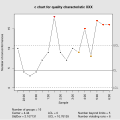Thursday, September 18, 2014
Wednesday, September 17, 2014
Sunday, September 14, 2014
PMP Process, Inputs & Outputs, Tools & Techniques - Full Single Page Diagram
Full process chart with knowledge areas, tools & techniques, inputs and outputs.
Click here to download
PMP Exam Preparation
If you are preparing for PMP exam, remembering all the process, tools & techniques and outputs will be a challenging task.
I found this matrix chart on http://www.proplanx.com/ and it think its quite useful. You must try this.
I found this matrix chart on http://www.proplanx.com/ and it think its quite useful. You must try this.
You can register and download this chart for free from http://www.proplanx.com/ Goto Free & then PMP Resources section.
Sunday, September 7, 2014
Software Development for Medical Devices
Until recently, safety regulations for medical device software, at least formally, were not exceptionally rigorous across the board. In addition, software was not formally classified as a medical product by the Medical Devices Directive. This has now changed. A new regime is in force governing all medical device software development for all classes of device.
Very good article on software development of medical devices click here to read.
Tuesday, September 2, 2014
Data Mining Algorithms
Choosing the Right Algorithm
Choosing the best algorithm to use for a specific analytical task can be a challenge. While you can use different algorithms to perform the same business task, each algorithm produces a different result, and some algorithms can produce more than one type of result. For example, you can use the Microsoft Decision Trees algorithm not only for prediction, but also as a way to reduce the number of columns in a dataset, because the decision tree can identify columns that do not affect the final mining model.
Choosing the best algorithm to use for a specific analytical task can be a challenge. While you can use different algorithms to perform the same business task, each algorithm produces a different result, and some algorithms can produce more than one type of result. For example, you can use the Microsoft Decision Trees algorithm not only for prediction, but also as a way to reduce the number of columns in a dataset, because the decision tree can identify columns that do not affect the final mining model.
Choosing an Algorithm by Type
Analysis Services includes the following algorithm types:
-
Classification algorithms predict one or more discrete variables, based on the other attributes in the dataset.
-
Regression algorithms predict one or more continuous variables, such as profit or loss, based on other attributes in the dataset.
-
Segmentation algorithms divide data into groups, or clusters, of items that have similar properties.
-
Association algorithms find correlations between different attributes in a dataset. The most common application of this kind of algorithm is for creating association rules, which can be used in a market basket analysis.
-
Sequence analysis algorithms summarize frequent sequences or episodes in data, such as a Web path flow.
Analysis Services includes the following algorithm types:
- Classification algorithms predict one or more discrete variables, based on the other attributes in the dataset.
- Regression algorithms predict one or more continuous variables, such as profit or loss, based on other attributes in the dataset.
- Segmentation algorithms divide data into groups, or clusters, of items that have similar properties.
- Association algorithms find correlations between different attributes in a dataset. The most common application of this kind of algorithm is for creating association rules, which can be used in a market basket analysis.
- Sequence analysis algorithms summarize frequent sequences or episodes in data, such as a Web path flow.
Subscribe to:
Posts (Atom)












%2B(1).gif)